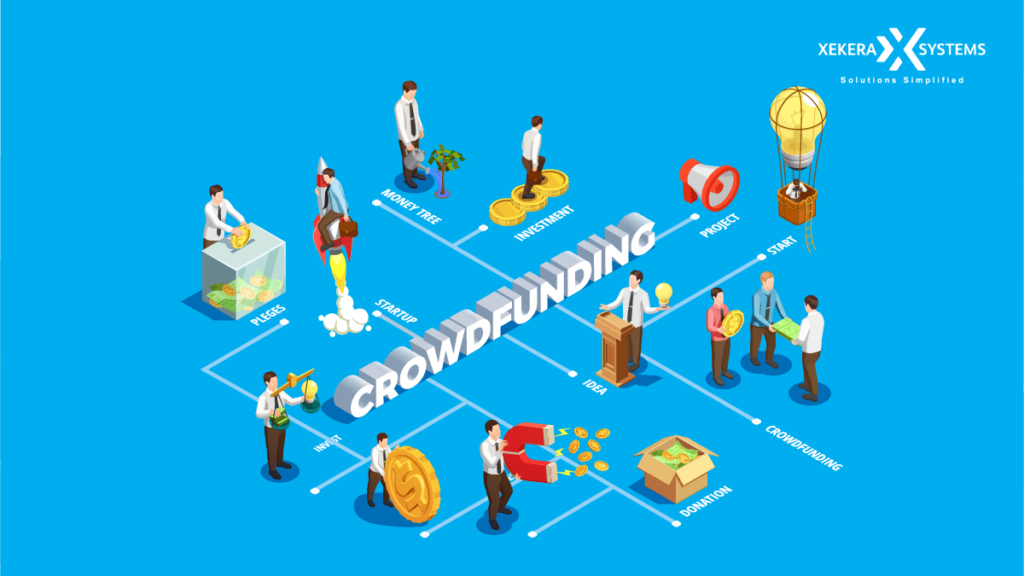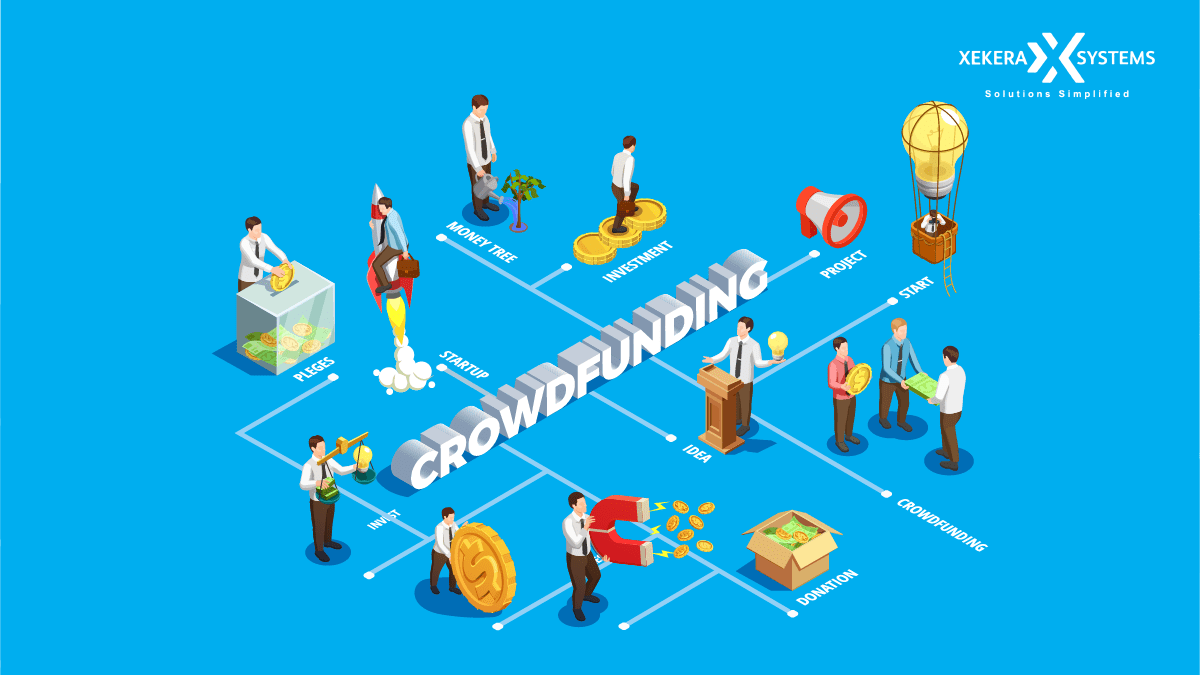Did you know that in North America alone, $17.2 billion is raised annually through crowdfunding websites/platforms? It will reach $300 billion by 2030.
Additionally, crowdfunding has become the primary source for many startups and entrepreneurs to find pre-seed and seed capital.
Whether you’re a small startup or a lone hustler, fundraising for your initiative is a top priority. Entrepreneurs often visit top crowdfunding websites and platforms to raise funds.
But “Is starting a crowdfunding platform a profitable idea?”
And I’m sure you have many other questions, such as ‘what is crowdfunding’ and ‘how to build a crowdfunding platform’.
So if you want to build a platform that fosters a thriving economy of self-starters, you may need to learn how to start a crowdfunding website. And if all of this overwhelms you, let’s decipher the open questions with our comprehensive guide that walks you through not just creating a crowdfunding platform, but raising funds. Let’s go over the basics.

What is crowdfunding?
Crowdfunding is a method of raising funds for a specific purpose. Funds can be raised for purposes such as businesses, projects, and charities. B. Such as technology or non-technology start-ups, non-profit organizations, or people paying for healthcare. For example, if you have a great idea, good reason, or a useful project that requires a large capital investment, you can share those ideas with others through crowdfunding platforms. It helps you raise money or small sums of money from a large number of people (whoever is interested will pay you).
How does crowdfunding work?
When you need funding for a great idea or cause, or for urgent medical bills, here’s how. Such (in need) people start their crowdfunding campaigns by putting their projects on the crowdfunding platform. You can also create your own crowdsourcing platform, place your project and raise funds.
Should You Create a Crowdfunding Platform?
Before we dive into how to get started with crowdfunding, let’s start with the crowdfunding facts you should know.
- 22% of crowdfunding campaigns worldwide are successful.
- crowdfunding contributes his $65 billion to the global economy.
- 64% of American consumers are aware of crowdfunding.
- If your crowdfunding campaign reaches 30% of your goal in the first week, it’s likely to be successful.
- 17% of crowdfunding donations are made via smartphones.
- 41.1% of crowdfunding campaigns were initiated by companies and entrepreneurs, followed by social causes (18.9%).
These facts will help you understand the essence of crowdfunding and prepare a solid strategy for your crowdfunding campaign. Now you have to decide if you want to start a crowdfunding platform. You may have heard of Kickstarter, GoFundMe, LendingClub, Indiegogo, and many other successful crowdsourcing platforms in their respective fields. You can draw inspiration from these platforms to make decisions.
Explore the core elements of creating a successful crowdfunding platform.
Find Your Target Audience Before Starting Your Crowdfunding Business
What kind of people do you want to attract on your platform? Instead of launching a crowdfunding platform where anyone can run a campaign, choose people
For example, Patreon is a crowdfunding site that helps YouTubers, musicians, artists, and other creators raise money for their businesses.
If you want to appeal to everyone, find the opportunity gap in your market. Individuals would rather run campaigns on the platform with like-minded people than go with big players. Choose your niche.
Competitor Research / Competitive Landscape Research
Competitor research can help you find a better niche. We focus on this part because the success of a crowdfunding platform lies behind the right niche, and the right niche emerges from the market niche and the fundraiser pain points.
You can see this in a thorough analysis of your competitors. We’ve collected a list of the best local, national, and international crowdfunding platforms, and go through them to find out how they’re making money from their platforms.
By working your way through these platforms, you’ll be able to think globally and act locally and understand how to build a crowdfunding company that works better at all levels.
Let us make your task easier by sharing more research that shows the market share of crowdfunding platforms.
Let’s explore some examples of the best crowdfunding organizations from different countries and regions.
| Regions | Top Crowdfunding Platforms |
|---|---|
| International | Indigogo FundingCircle Patreon Fundrazr GoFundMe Eureeca |
| Asia | Japan: AirFunding, Camp-fire South Korea: TumblBug China: DemoHour Indonesia: Kitabisa Singapore: Give.Asia Malaysia: Mystartr India: Ketto Thailand: Weeboon |
| Middle East | Zoomaal Yomken |
| Europe | UK: Seedrs, CrowdCube France: Ulule, KissKissBankBank Spain: Goteo The Netherlands: Symbid Belgium: Spreds Sweden: FundedByMe Switzerland: WeMakeIt Finland: Invesdor Invesdor: Booomerang |
| North America/South America | Indigogo FundingCircle Patreon Fundrazr GoFundMe Kickstarter SeedInvest TransparentHands FrontFundr Vested Kickante Catarse Idea |
| Africa | Morocco: Cotizi Tunisia: Cofundy Algeria: Twiiza |
These platforms will help you understand how to think globally, act locally, and start a better performing crowdfunding business at any scale.
Apart from these, there are plenty of other sectors that have come into limelight over the years to use crowdsourcing platforms to raise funds. They are;
- IT startups
- Science and research
- Personal
- Education
- Sport
- Local food business
- Agriculture
- Minorities
And more.
Juggling How to Create a Crowdfunding Platform?
First, choose the right business model
If you want to create a crowdfunding platform, you need to choose the right crowdfunding business model. There are four main types of models.
- Donation-based crowdfunding
- Rewards-based crowdfunding
- Peer-to-peer loans
- Equity-based crowdfunding
Donation-based crowdfunding: Donation-based crowdfunding is when donations are collected for social or charitable purposes. In this case, the donor donates the money without expecting it to be returned. Such crowdfunding is used by non-profit and non-governmental organizations and sometimes by individuals for specific reasons such as medical expenses.
Reward-Based Crowdfunding: Pre-sale purchases are common today when supporters, donors or investors invest money in exchange for specific rewards associated with the projects they support. For example, many companies, especially innovation startups and product developers, have ideas and prototypes.
Crowdfunding platforms allow businesses to reward their support or initiate pre-sales to raise funds. The funds raised will be used for product development.
In short, people can donate or sponsor a new product line and in return own the product (if it’s fully developed or available). Opt to create a reward-based crowdfunding platform if you are looking for a more compelling project that attracts and monetizes donors by convincing them that they will get rewards in return is needed.
Peer-to-Peer Lending: Peer-to-Peer Lending is where you receive money from an investor or other person without the help of an intermediary (bank or other financial institution). In other words, investors lend money in the hope of earning interest.
Equity-Based Crowdfunding: If you want to start a crowdfunding business that will benefit your donors and investors, equity-based crowdfunding is your best bet. In doing so, the platform allows ordinary individuals to become part of trading companies by inviting them to invest in the company. Those who support the commercial enterprise become part of it as owners of the securities. This means that investors who invest through the platform also become stakeholders in the company.
The right revenue models pave the way for starting a crowdfunding business
- Commission/success fee
- Membership fee
- Paid services and features on the website
- Advertisements and promotions
Once you have decided on your model, you need a way to monetize these campaigns on your platform. You can charge a commission from the funds raised or have campaign runners subscribe to the platform for a monthly fee.You can also rent spots to paid ads and charge for each campaign running on the platform. Yes, there are many ways to implement monetization on your crowdfunding platform. Let’s explore some of the main revenue models.
Fees/Contingency Fees
Fee-based (also known as the success-based revenue model) is widespread and most crowdfunding companies use this model to generate revenue. As a crowdfunding platform, we receive a percentage of the amount raised. In some cases, investors are responsible for percentages only after the necessary or required amount or target has been raised or achieved.
Let’s take a look at a Kickstarter example that earns a 5% commission each time a fundraising goal is met. However, for this revenue model to be successful, quality projects must ensure a constant flow from investors and fundraiser.
Membership Fees
You can also initiate a member revenue model by allowing fundraisers and campaign her leaders to subscribe to the platform for a monthly fee. Subscribers or fundraisers can then use the platform to run crowdfunding campaigns. An example could be Fundable, which charges subscribers $179 per month. The Patreon app is also another membership platform where creators can build their own following and get paid for the value they provide. They pay the platform the amount they receive.
Paid Site Services and Features
As a crowdfunding platform, campaigns can help her leaders manage campaigns, create prototypes and publish video ads, brand with compelling messages, and more.
In return, fundraisers pay the platform for their support. You can see many examples online of crowdfunding platforms supporting people’s aims and ideas. In this case, campaign runners come up with ideas and the rest is managed by the crowdfunding platform.
Advertising and Promotions
If you have a large number of subscribers, you can implement advertising or promotion-based revenue models. You can also allow fundraisers to use your platform to promote campaigns and receive a certain amount in return.
Build a crowdfunding platform
Now that the planning for building a crowdfunding platform is complete, it’s time to get down to the technical work and build the platform. There are several ways to create a crowdfunding website.
You can choose a CMS like WordPress or a white label platform. It doesn’t take long and is quick to boot, but it has a significant drawback. This means they may not be customizable, have mismatched technology stacks, pre-built functionality, etc., and may not fit your use case well.
However, if you choose to build your crowdfunding platform from scratch, you are free to customize it. Our experienced team of web and mobile app developers can help you build the crowdfunding platform you want from the ground up. With the right crowdfunding design methodology and development framework for your use case, your crowdfunding project will be up and running in no time.
Final Thoughts
Declined during the pandemic, but its vibrant startup culture is poised to boom in the years to come. As a result, the need for reliable open source crowdfunding platforms will increase.
If you are new to crowdfunding, you should proceed with caution. One wrong step and your initiative could be boosted. Don’t be afraid to brainstorm your ideas with the help of an expert and come up with a plan to perfect them.
In order to build a robust crowdfunding for startups, we will help you from idea generation to planning and implementation (design, development, deployment) all at low cost. Contact us today for more information.



